Shibumi (Los Angeles, CA) [2]
Shibumi Restaurant
815 S Hill St, Los Angeles, CA 90014
323-484-8915
www.shibumidtla.com
Sun 06/22/2025, 06:35p-10:00p
+20250622_183525+20250622_183524+20250622_183522+20250622_183520.jpg)
The last time I reported on David Schlosser was back in June 2016, right after the opening of Shibumi (渋み) in Downtown's Historic Core. The kappo-style eatery was well-received by critics, garnering a four-star review in LA Weekly, the #2 spot on Jonathan Gold's "101 Best Restaurants" list, and even a Michelin star in the 2019 guide (which has been retained ever since). Despite the accolades, the spot never really seemed to catch on with the locals, but apparently has done well enough to allow the Chef to expand his reach.
June 2021 witnessed the debut of Imari (いまり) in Brentwood, a joint effort between Schlosser and restaurateur Philip Camino (Fellow, The Hudson, etc.). Running the day-to-day at the washoku-ish spot was Chef de Cuisine Derek Wilcox, a Virginia-raised upstate New York native who came over from Manhattan's Shoji at 69 Leonard Street. Previously, he'd worked at Ginza Sushi Aoki (銀座 鮨青木), including at the restaurant's branch in Nishi-Azabu, and prior to that, trained at the iconic kaiseki-ya Kikunoi (菊乃井) in Kyoto following his move to Japan after culinary school.
However, Schlosser's involvement didn't last long, and in August 2022, Imari was renamed Kiitsu (帰一), while ownership of the business changed hands in early 2023 (this might've had something to do with Camino being charged with PPP loan fraud, among other transgressions). With that shakeup, Wilcox also jumped ship and joined the Shibumi team as CdC, with the official announcement coming in May that year.
Despite the unfortunate experience with Imari, Schlosser still had expansion on his mind, and in April 2024, launched Kushiba, a kushikatsu specialist in the old Bar Caló space in Echo Park. His partner there was Simon Xi of the NYC-based All Blue Hospitality (f.k.a. Z Hospitality), who's also involved with Shibumi. However, Kushiba apparently didn't do all that well, and in September, it was transformed into A Tí, Chef Andrew Ponce's contemporary taquería that's still on my list to try.

Pictured above is the view from my position at Shibumi's 15-seater counter, reportedly fashioned out of a slab of 400-plus-year-old sinker cypress wood sourced from a Louisiana bayou.

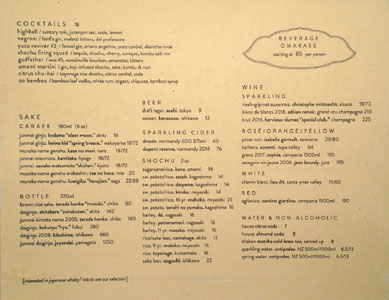
Shibumi's menu is pleasantly compact, and though à la carte ordering is possible, we went with the seven-course omakase ($125), presented tonight by Chef Wilcox. To drink, you get a selection of cocktails, sake, beer/cider, shochu, wine, and one of the lengthiest Japanese whisky lists in LA (not pictured). Corkage is $30 a bottle, but was graciously waived tonight. Click for larger versions.
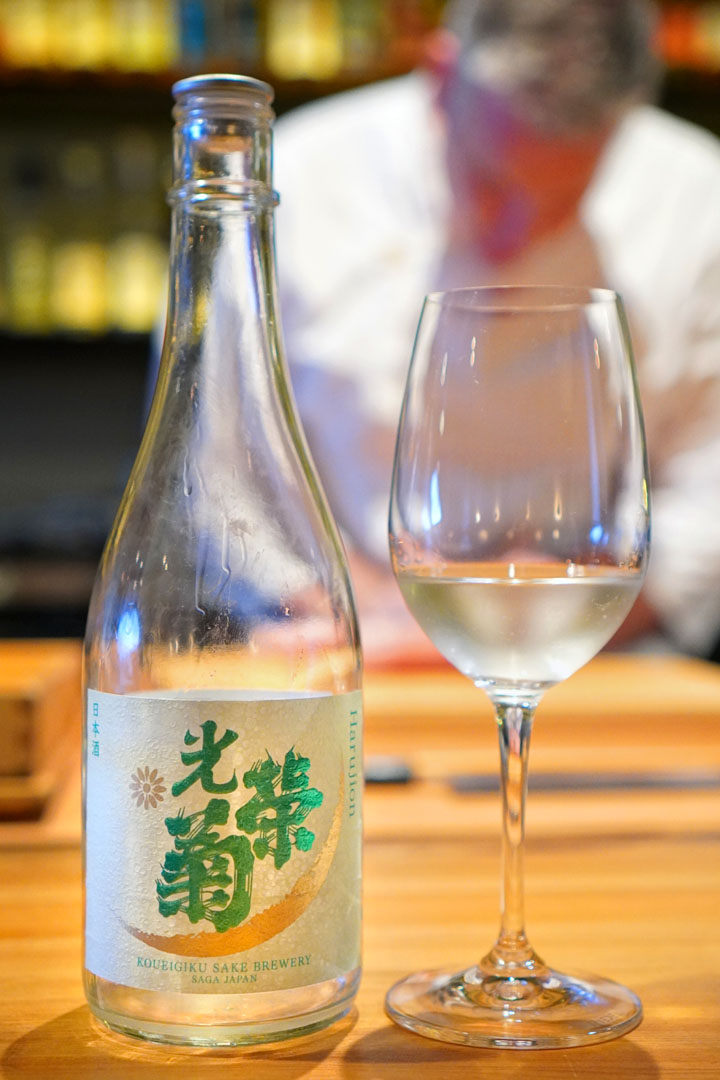
Upon being seated, I was quickly presented with a complimentary pour of the muroka nama genshu, koueigiku "harujion," saga. This was sweet and fruity on the nose, with a distinct pineapple character supported by an undercurrent of cooked rice. On the palate, the sake once again displayed plenty of tart, tropical flavors, set over layers of ricey umami, acidity, and bitterness. Refreshing, easy-going, and a fitting "welcome" libation.

1: Sakizuke
Dinner commenced with a trio of zensai. Counter-clockwise from bottom, we had:

2: japanese tai bream | fresh wasabi, soy-cured stems
Next came three different preparations of madai, accompanied by soy sauce, Half Moon Bay wasabi, shiso, and slivers of wonderfully zippy myoga: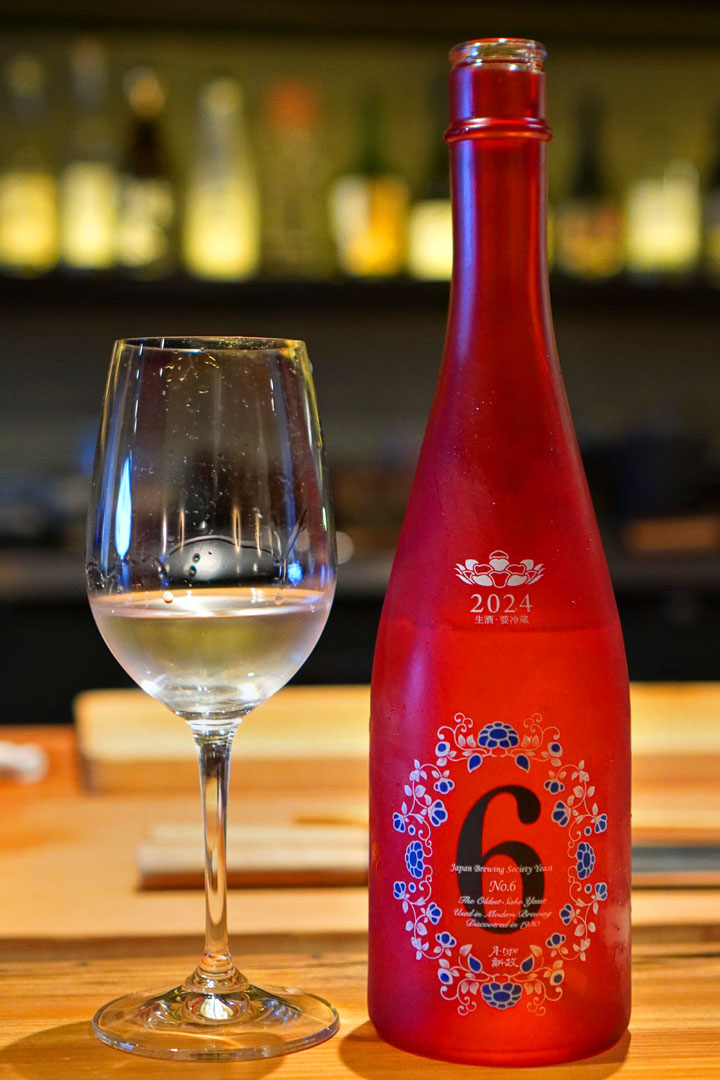
To pair with our meal, we BYOB'd three bottles, the first of which was the 2024 Aramasa No. 6 A-type (新政 ナンバーシックス エータイプ), which was actually just released on June 6th to commemorate the brewery's signature No. 6 yeast. The namazake was brewed using the kimoto junmai method with wooden barrels, and made use of 2024 harvest Akita Sake Komachi rice polished to 66%. The resulting liquid was delish, showcasing a fresh, invigorating, but delicate nose filled with tropical fruit and this almost lactic quality. On the palate, I found the nihonshu just the slightest bit effervescent, yet silken and smooth, its sweet, refreshing character undergirded by a palpable weightiness and hints of umami.
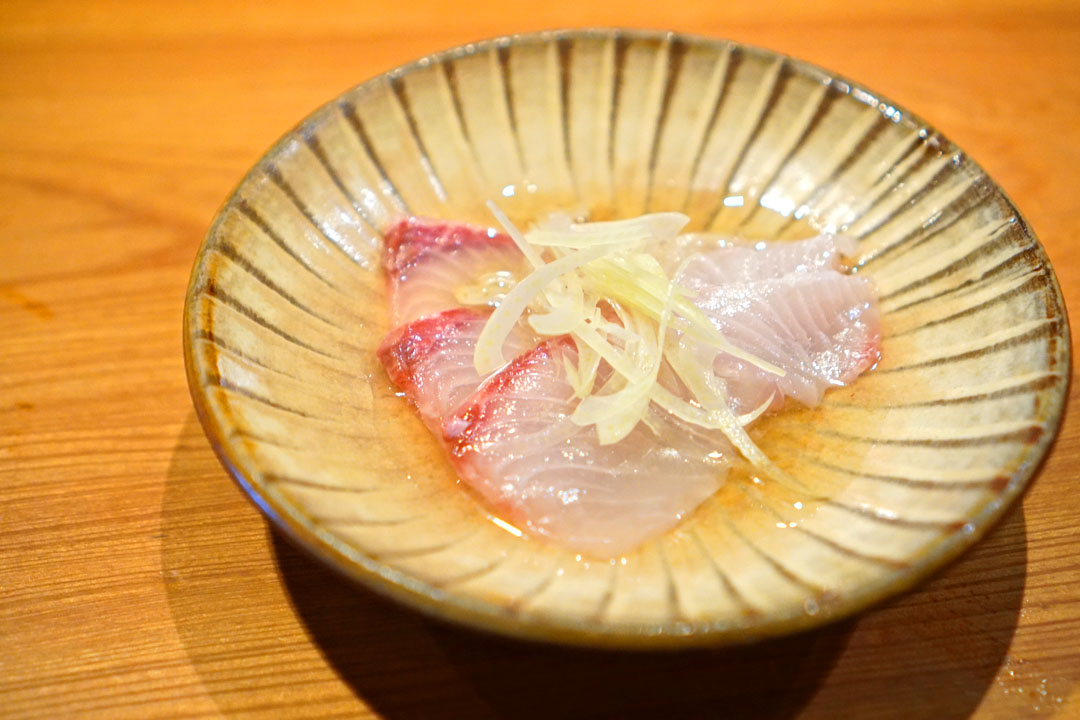
3: kanpachi amberjack | shaved fennel, salt ponzu
I don't think I've ever had amberjack sashimi paired with fennel before, but it was a superb match-up thanks to how well the anise-y notes from herb countered the robust flavors of the fish, with the salty-citrusy nature of the shio ponzu helping to tie it all together.


4: unagi kara-age | cucumber, dashi, grated radish and ginger
I've had plenty of unagi over the years, but never in karaage form, which is shame, because it's a great way to consume the fish. I appreciated the juxtaposition of the eel's tender insides and light, crispy exteriors, while its subtly sweet-saline flavors were nicely married with both cucumber and a daikon-oroshi-boosted dashi. This dish even managed to convince an unagi hater in my party, who ate everything.
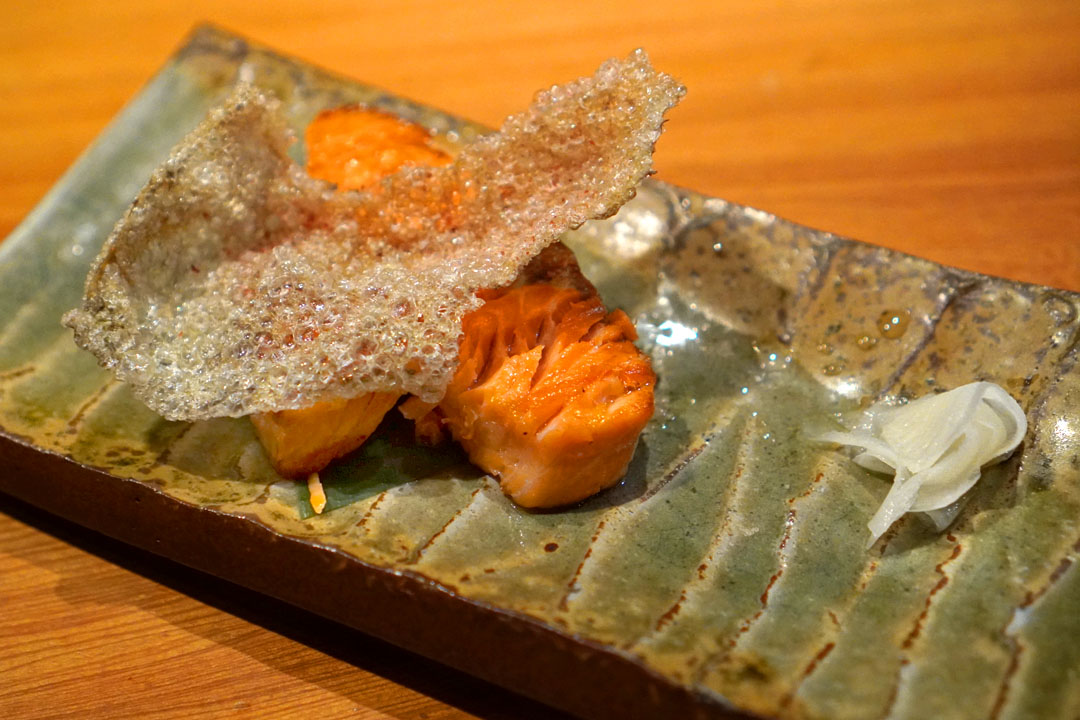
5: salmon trout, smoked in cherry bark
Trout arrived just the slightest bit rare, which I prefer. The fish ate delectably full-flavored, its richness and brine well-matched by those shavings of pickled daikon, all while the fried skin imparted both crunch and further hits of salt.
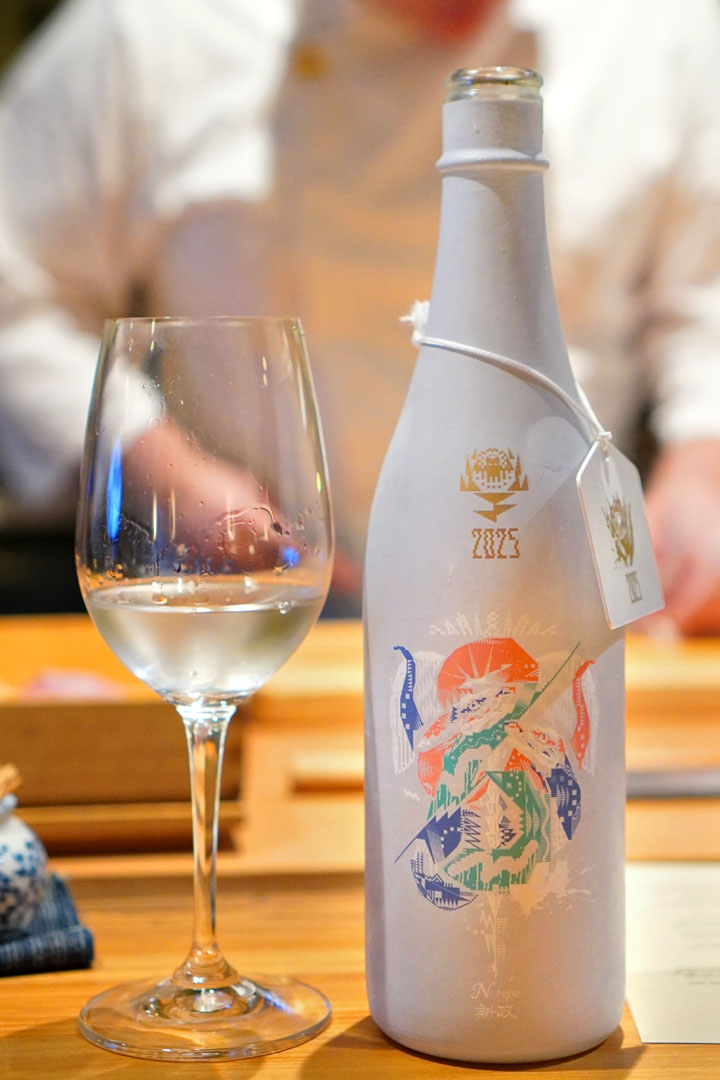
Our second bottle was the 2025 Aramasa No. 6 NewYear-type Direct Path (新政 ナンバーシックス ニューイヤータイプ ダイレクトパス), also known as the N-type Year of the Snake (蛇 乙巳). The unpasteurized sake was reportedly pressed from the end of 2024 to the beginning of 2025 and shipped on New Year's Day, with the intent of making it an auspicious beverage. A wooden barrel-brewed junmai made from 2024 harvest Akita Prefecture rice polished to 55%, this demonstrated a woodier, earthier aroma compared to the A-type above, with a decidedly "cool," mineral-driven character. However, that bouquet belied the palate, which was velvety, bright, fresh, and sweet, with a distinctly pineapple-like quality perked up by light pinpricks of umami and barrel astringency. Do also note the neat artwork on the bottle, created by pixel artist ヘルミッペ (Hermippe).

kagoshima wagyu beef [$82.00/4oz]
We supplemented our meal with a platter of Kagoshima beef, which came out as fatty and savory and smoky as I wanted, but with a certain elegance. The meat was joined by picked gourd narazuke, shishito peppers, and a healthy mound of fresh wasabi.
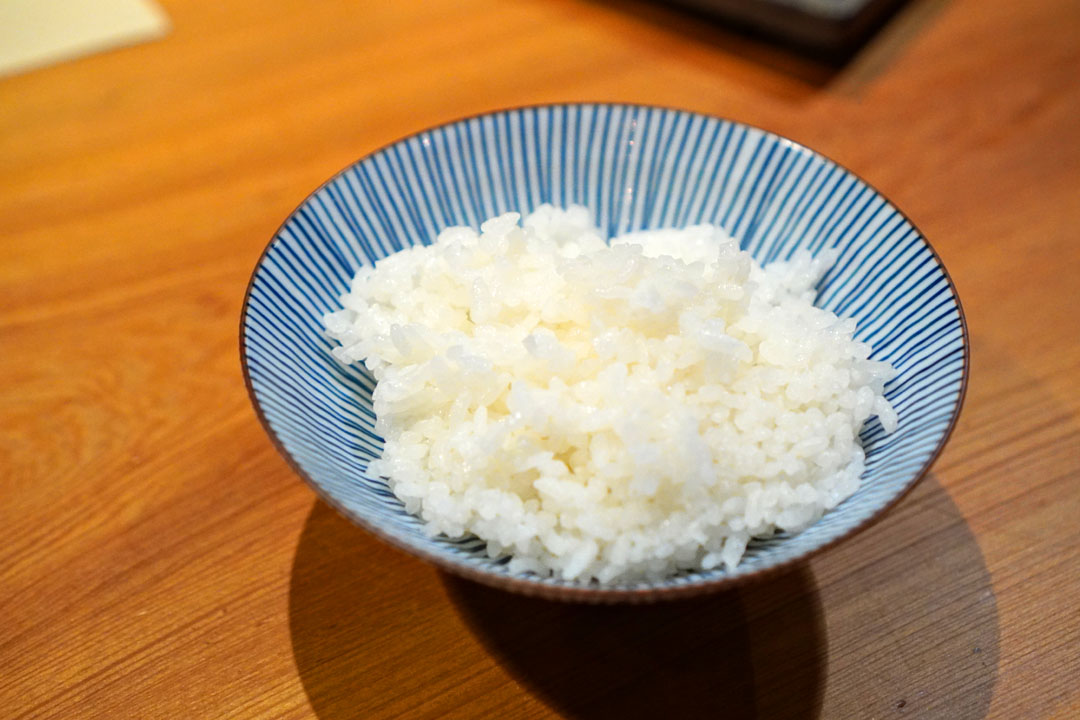


6: steamed rice in an iron pot | ginga-no-shizuku variety, iwate japan, served with fermented vegetables
Soft, fluffy, semi-sticky rice from Iwate Prefecture arrived with burdock and chayote oshinko, as well as a sweeter-than-usual miso soup.

baby anchovy tsukudani [$16.00]
The tsukudani was as aggressively salty and savory as I expected, but with an undercurrent of sweetness, and worked as a complement to the unseasoned rice above.
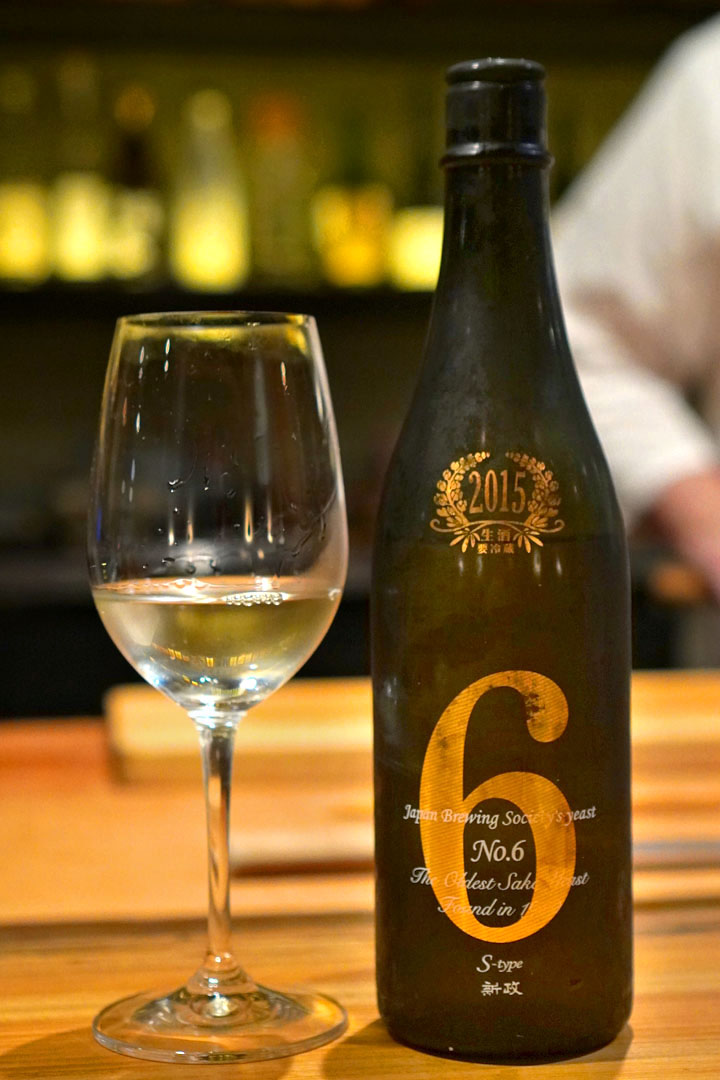
Our third and final BYO bottle was the 2015 Aramasa No. 6 S-type (新政 ナンバーシックス エスタイプ), an aged kimoto junmai-style namazake made with 2015 harvest rice from Akita Prefecture (seimai-buai: 50%). This one exhibited a mature nose filled with mustier, more saline sensations along with elements of sweetness. Taking a sip, the liquid was velvety on the tongue, but still faintly sparkling, offering nuances of spice, heat, and just enough fruitiness to keep things a bit vivacious. I don't think I've had a sake this old before, but I have to say that it's aged quite gracefully, so it was a real treat to be able to experience it tonight.

hokkaido scallop [$34.00] | stem lettuce, kimizu sauce
Further supplemental dishes included a lovely presentation of scallops, which played the cool brine of the bivalves against a creamy, eggy, semi-sweet sauce, all while the celtuce imparted both crunch and brightness.
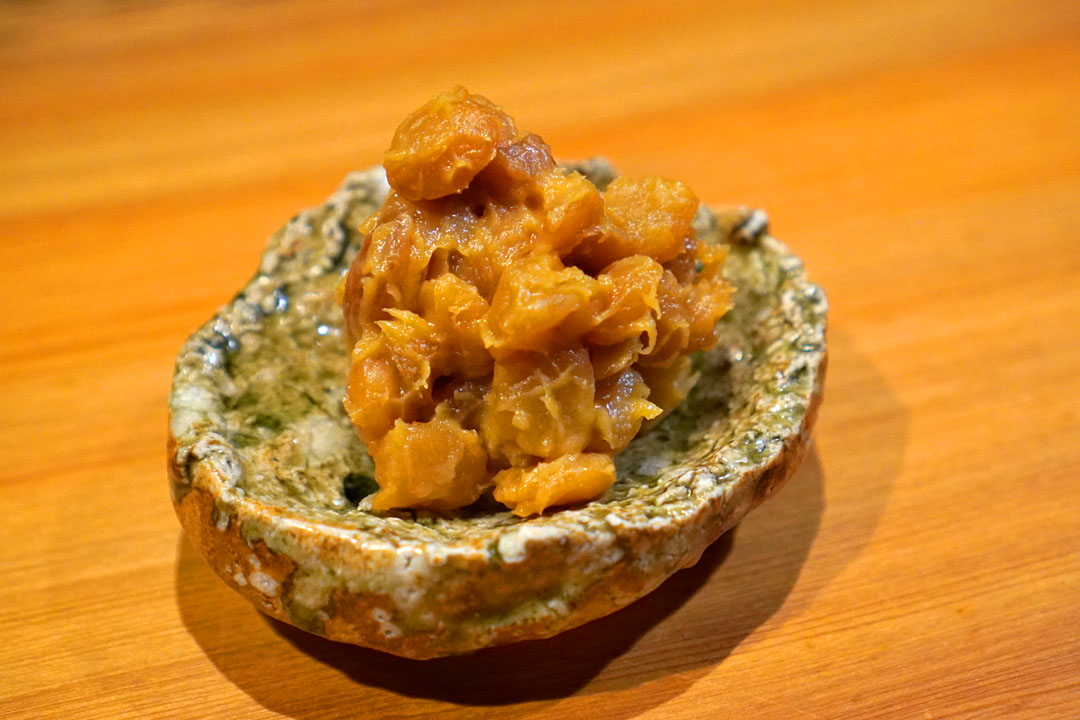
spanish almonds, white miso [$8.00]
Almonds did a nice job serving as a foil to the sweet-n-savory smack of shiromiso.
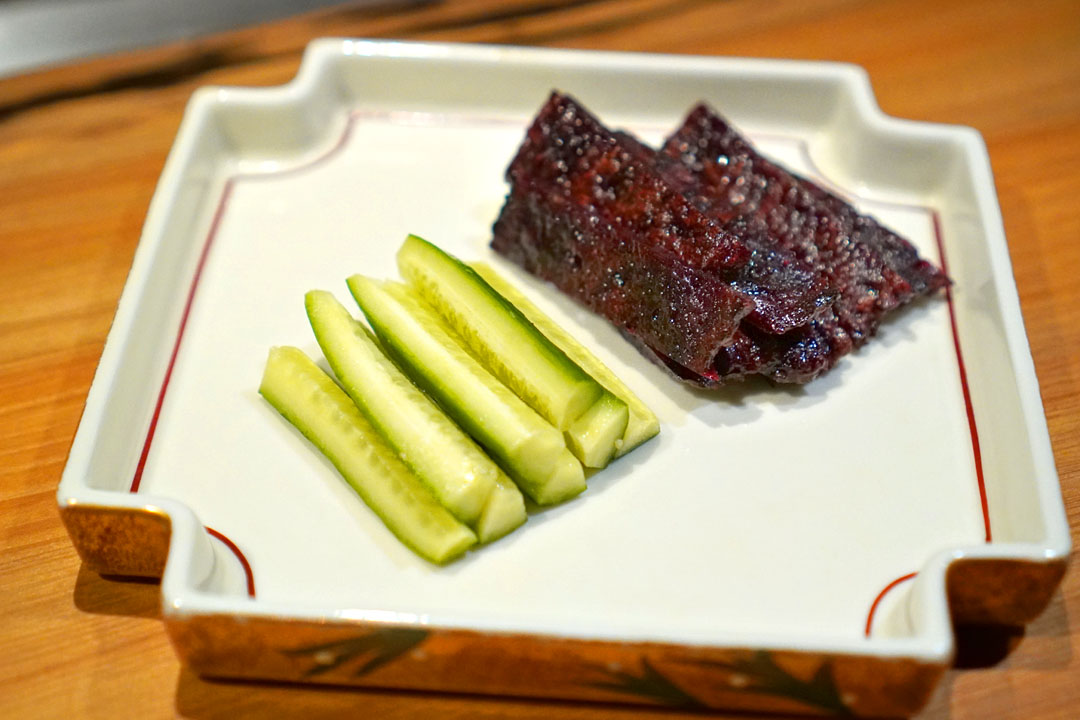
red koji pork jerky [$12.00] | with cucumber
Strips of jerky were a joy texturally--think light and delicate, but with just enough chew and a subtle crispness--while taste-wise, they offered up a mouthwatering mix of sweet and porcine flavors.
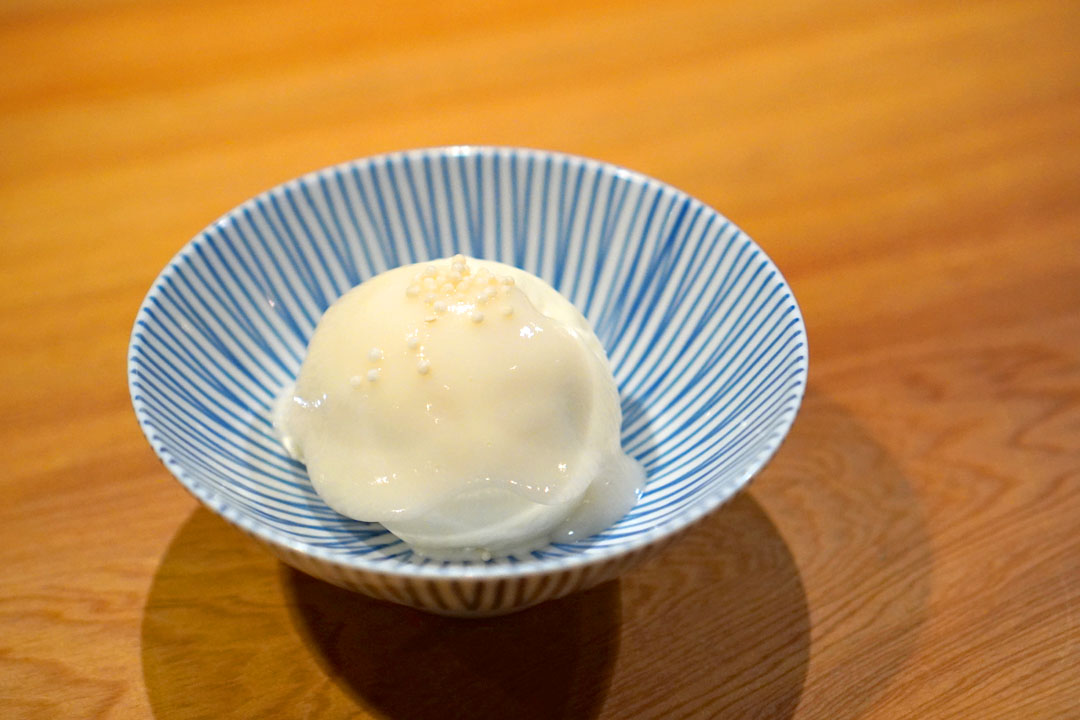
7: koji (r)ice cream | topped with crispy rice pearls
Time for dessert. A rice mold-enhanced ice cream possessed a delightfully earthy sweetness, with a bit of an herby bent to boot.
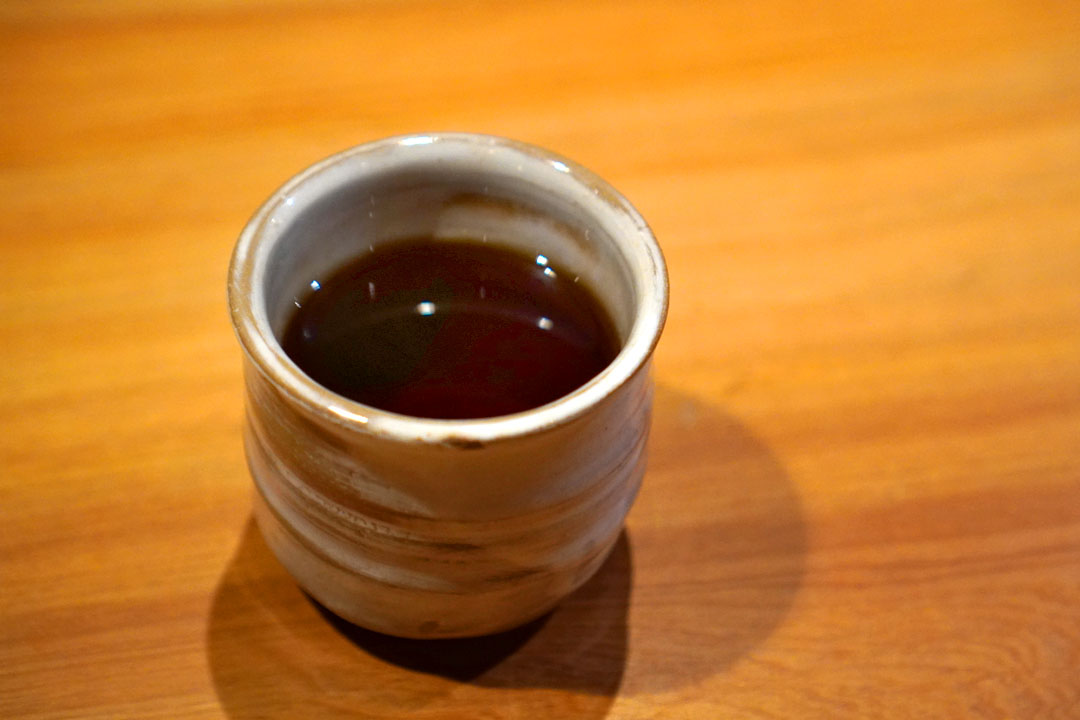
A cup of hot, roasty hojicha served as an appropriate closer.
It'd been a while since my last meal at Shibumi, but I'm glad that I finally made it back here. I was pleased with dinner tonight, and I think what I appreciate about this place is how the kitchen is doing Japanese cuisine just a bit differently compared to most spots around LA, being not afraid to feature some lesser-known preparations, or incorporate elements that aren't strictly traditional. I feel like Shibumi has to be one of the most underrated Japanese eateries in town, and now I'm curious to try the restaurant's higher-end, kaiseki-inspired tasting menu option somewhere down the line.

815 S Hill St, Los Angeles, CA 90014
323-484-8915
www.shibumidtla.com
Sun 06/22/2025, 06:35p-10:00p
+20250622_183525+20250622_183524+20250622_183522+20250622_183520.jpg)
The last time I reported on David Schlosser was back in June 2016, right after the opening of Shibumi (渋み) in Downtown's Historic Core. The kappo-style eatery was well-received by critics, garnering a four-star review in LA Weekly, the #2 spot on Jonathan Gold's "101 Best Restaurants" list, and even a Michelin star in the 2019 guide (which has been retained ever since). Despite the accolades, the spot never really seemed to catch on with the locals, but apparently has done well enough to allow the Chef to expand his reach.
June 2021 witnessed the debut of Imari (いまり) in Brentwood, a joint effort between Schlosser and restaurateur Philip Camino (Fellow, The Hudson, etc.). Running the day-to-day at the washoku-ish spot was Chef de Cuisine Derek Wilcox, a Virginia-raised upstate New York native who came over from Manhattan's Shoji at 69 Leonard Street. Previously, he'd worked at Ginza Sushi Aoki (銀座 鮨青木), including at the restaurant's branch in Nishi-Azabu, and prior to that, trained at the iconic kaiseki-ya Kikunoi (菊乃井) in Kyoto following his move to Japan after culinary school.
However, Schlosser's involvement didn't last long, and in August 2022, Imari was renamed Kiitsu (帰一), while ownership of the business changed hands in early 2023 (this might've had something to do with Camino being charged with PPP loan fraud, among other transgressions). With that shakeup, Wilcox also jumped ship and joined the Shibumi team as CdC, with the official announcement coming in May that year.
Despite the unfortunate experience with Imari, Schlosser still had expansion on his mind, and in April 2024, launched Kushiba, a kushikatsu specialist in the old Bar Caló space in Echo Park. His partner there was Simon Xi of the NYC-based All Blue Hospitality (f.k.a. Z Hospitality), who's also involved with Shibumi. However, Kushiba apparently didn't do all that well, and in September, it was transformed into A Tí, Chef Andrew Ponce's contemporary taquería that's still on my list to try.

Pictured above is the view from my position at Shibumi's 15-seater counter, reportedly fashioned out of a slab of 400-plus-year-old sinker cypress wood sourced from a Louisiana bayou.


Shibumi's menu is pleasantly compact, and though à la carte ordering is possible, we went with the seven-course omakase ($125), presented tonight by Chef Wilcox. To drink, you get a selection of cocktails, sake, beer/cider, shochu, wine, and one of the lengthiest Japanese whisky lists in LA (not pictured). Corkage is $30 a bottle, but was graciously waived tonight. Click for larger versions.

Upon being seated, I was quickly presented with a complimentary pour of the muroka nama genshu, koueigiku "harujion," saga. This was sweet and fruity on the nose, with a distinct pineapple character supported by an undercurrent of cooked rice. On the palate, the sake once again displayed plenty of tart, tropical flavors, set over layers of ricey umami, acidity, and bitterness. Refreshing, easy-going, and a fitting "welcome" libation.

1: Sakizuke
Dinner commenced with a trio of zensai. Counter-clockwise from bottom, we had:
- Hoshigaki (dried persimmon) had the sugary depth I was looking for, as well as a satisfyingly sticky, chewy texture.
- Kyoto-style tazuna-maki was something I'd not had before, so it was great to see it on the menu tonight. A variation on bozushi featuring diagonally-arranged toppings inspired by traditional Japanese horse reins, it showed off the strongly saline flavors of iwashi (sardine), offset by soft, mild rice and the sting of house-pickled ginger.
- Last up were local heirloom black Brandywine tomatoes, which had their sweet-tartness beautifully accompanied by the nuttiness of yuba.


2: japanese tai bream | fresh wasabi, soy-cured stems
Next came three different preparations of madai, accompanied by soy sauce, Half Moon Bay wasabi, shiso, and slivers of wonderfully zippy myoga:
- I began with a prototypical cut of sashimi, taken from the back of the fish, and enjoyed its soft-but-"snappy" consistency, while its clean, almost nutty flavors linked up easily with both soy and wasabi.
- Next came the belly of the sea bream, which displayed a noticeably fattier, more luxuriant mouthfeel and a slightly more assertive taste.
- My favorite item here, though, was the skin, simmered in dashi until its natural gelatin was released. This resulted in an almost aspic-like preparation, one loaded with plenty of brine and umami.

To pair with our meal, we BYOB'd three bottles, the first of which was the 2024 Aramasa No. 6 A-type (新政 ナンバーシックス エータイプ), which was actually just released on June 6th to commemorate the brewery's signature No. 6 yeast. The namazake was brewed using the kimoto junmai method with wooden barrels, and made use of 2024 harvest Akita Sake Komachi rice polished to 66%. The resulting liquid was delish, showcasing a fresh, invigorating, but delicate nose filled with tropical fruit and this almost lactic quality. On the palate, I found the nihonshu just the slightest bit effervescent, yet silken and smooth, its sweet, refreshing character undergirded by a palpable weightiness and hints of umami.

3: kanpachi amberjack | shaved fennel, salt ponzu
I don't think I've ever had amberjack sashimi paired with fennel before, but it was a superb match-up thanks to how well the anise-y notes from herb countered the robust flavors of the fish, with the salty-citrusy nature of the shio ponzu helping to tie it all together.


4: unagi kara-age | cucumber, dashi, grated radish and ginger
I've had plenty of unagi over the years, but never in karaage form, which is shame, because it's a great way to consume the fish. I appreciated the juxtaposition of the eel's tender insides and light, crispy exteriors, while its subtly sweet-saline flavors were nicely married with both cucumber and a daikon-oroshi-boosted dashi. This dish even managed to convince an unagi hater in my party, who ate everything.

5: salmon trout, smoked in cherry bark
Trout arrived just the slightest bit rare, which I prefer. The fish ate delectably full-flavored, its richness and brine well-matched by those shavings of pickled daikon, all while the fried skin imparted both crunch and further hits of salt.

Our second bottle was the 2025 Aramasa No. 6 NewYear-type Direct Path (新政 ナンバーシックス ニューイヤータイプ ダイレクトパス), also known as the N-type Year of the Snake (蛇 乙巳). The unpasteurized sake was reportedly pressed from the end of 2024 to the beginning of 2025 and shipped on New Year's Day, with the intent of making it an auspicious beverage. A wooden barrel-brewed junmai made from 2024 harvest Akita Prefecture rice polished to 55%, this demonstrated a woodier, earthier aroma compared to the A-type above, with a decidedly "cool," mineral-driven character. However, that bouquet belied the palate, which was velvety, bright, fresh, and sweet, with a distinctly pineapple-like quality perked up by light pinpricks of umami and barrel astringency. Do also note the neat artwork on the bottle, created by pixel artist ヘルミッペ (Hermippe).

kagoshima wagyu beef [$82.00/4oz]
We supplemented our meal with a platter of Kagoshima beef, which came out as fatty and savory and smoky as I wanted, but with a certain elegance. The meat was joined by picked gourd narazuke, shishito peppers, and a healthy mound of fresh wasabi.



6: steamed rice in an iron pot | ginga-no-shizuku variety, iwate japan, served with fermented vegetables
Soft, fluffy, semi-sticky rice from Iwate Prefecture arrived with burdock and chayote oshinko, as well as a sweeter-than-usual miso soup.

baby anchovy tsukudani [$16.00]
The tsukudani was as aggressively salty and savory as I expected, but with an undercurrent of sweetness, and worked as a complement to the unseasoned rice above.

Our third and final BYO bottle was the 2015 Aramasa No. 6 S-type (新政 ナンバーシックス エスタイプ), an aged kimoto junmai-style namazake made with 2015 harvest rice from Akita Prefecture (seimai-buai: 50%). This one exhibited a mature nose filled with mustier, more saline sensations along with elements of sweetness. Taking a sip, the liquid was velvety on the tongue, but still faintly sparkling, offering nuances of spice, heat, and just enough fruitiness to keep things a bit vivacious. I don't think I've had a sake this old before, but I have to say that it's aged quite gracefully, so it was a real treat to be able to experience it tonight.

hokkaido scallop [$34.00] | stem lettuce, kimizu sauce
Further supplemental dishes included a lovely presentation of scallops, which played the cool brine of the bivalves against a creamy, eggy, semi-sweet sauce, all while the celtuce imparted both crunch and brightness.

spanish almonds, white miso [$8.00]
Almonds did a nice job serving as a foil to the sweet-n-savory smack of shiromiso.

red koji pork jerky [$12.00] | with cucumber
Strips of jerky were a joy texturally--think light and delicate, but with just enough chew and a subtle crispness--while taste-wise, they offered up a mouthwatering mix of sweet and porcine flavors.

7: koji (r)ice cream | topped with crispy rice pearls
Time for dessert. A rice mold-enhanced ice cream possessed a delightfully earthy sweetness, with a bit of an herby bent to boot.

A cup of hot, roasty hojicha served as an appropriate closer.
It'd been a while since my last meal at Shibumi, but I'm glad that I finally made it back here. I was pleased with dinner tonight, and I think what I appreciate about this place is how the kitchen is doing Japanese cuisine just a bit differently compared to most spots around LA, being not afraid to feature some lesser-known preparations, or incorporate elements that aren't strictly traditional. I feel like Shibumi has to be one of the most underrated Japanese eateries in town, and now I'm curious to try the restaurant's higher-end, kaiseki-inspired tasting menu option somewhere down the line.

0 Comments:
Post a Comment
Subscribe to Post Comments [Atom]
<< Home